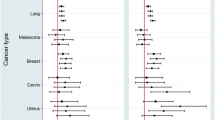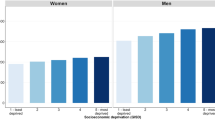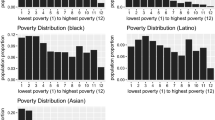Abstract
Objectives of study
To test recent claims that cancer inequities are bound to increase as population health improves.
Methods
We analyzed 1960–2006 age-standardized US county cancer mortality data, total and site-specific (lung, prostate, colorectal, breast, cervix, stomach), stratified by county income quintile for the US total, black, and white populations.
Results
Between 1960 and 2006, US socioeconomic inequities in cancer mortality variously shrunk, widened, reversed, and stagnated, depending on time period and cancer site. For all cancers combined and most, but not all, sites, absolute, but not relative, socioeconomic gaps were greater for the black compared to white population. Compared to the yearly age-specific mortality rates among whites in the most affluent counties, the percent of excess cancer deaths among whites in the lower four county income quintiles first rose above 0 in 1990 and in 2006 equaled 5.4% (95% CI 4.8, 6.0); among blacks, it rose from 6.0% (95% CI 4.5, 7.4) in 1960 to 24.7% (95% CI 23.9, 25.5) in 1990 and remained at this level through 2006.
Conclusions
The hypothesis that cancer mortality inequities are bound to increase is refuted by long-term data on total and site-specific cancer mortality stratified by socioeconomic position and race/ethnicity.








Similar content being viewed by others
Abbreviations
- CDC:
-
Centers for disease control and prevention
- CI:
-
Confidence interval
- ICD:
-
International classification of disease
- MRD:
-
Mortality rate difference
- MRR:
-
Mortality rate ratio
- NCHS:
-
National center for health statistics
- PAF:
-
Population attributable fraction
References
Kunst AE, Looman CW, Mackenbach JP (1990) Socio-economic mortality differences in The Netherlands in 1950–1984: a regional study of cause-specific mortality. Soc Sci Med 31:141–152
Ezzati M, Friedman AB, Kulkarni SC, Murray CJ (2008) The reversal of fortunes: trends in county mortality and cross-county mortality disparities in the United States. PLoS Med 5:e66. Erratum (2008) in: PLoS Med 5(5) doi:10.1371/journal.pmed.0050119
Kinsey T, Jemal A, Liff J, Ward E, Thun M (2008) Secular trends in mortality from common cancers in the United States by educational attainment, 1993–2001. J Natl Cancer Inst 100:1003–1012
Singh GK, Miller BA, Hankey BG, Feuer EJ, Pickle LW (2002) Changing area socioeconomic patterns in US cancer mortality, 1950–1998: Part I—all cancers among men. J Natl Cancer Inst 94:904–915
Singh GK, Miller BA, Hankey BF (2002) Changing area socioeconomic patterns in US cancer mortality, 1950–1998: Part II–Lung and colorectal cancers. J Natl Cancer Inst 94:916–925
Steenland K, Henley J, Thun M (2002) All-cause and cause-specific death rates by educational status for two million people in two American Cancer Society cohorts, 1959–1996. Am J Epidemiol 156:11–21
Strand BH, Grøholt EK, Steingrίmsdøtter OA, Blakely T, Graff-Iversen S, Naess Ø (2010) Educational inequalities in mortality over four decades in Norway: prospective study of middle aged men and women followed for cause specific mortality, 1960–2000. BMJ 304:c654 doi:10.1136/bmj.c654. Erratum in: BMJ 2010; 340:c1803
Logan WPD (1982) Cancer mortality by occupation and social class. (Studies on medical and population subjects No. 44). London: Her Majesty’s Stationery Office; Lyon: International Agency for Research on Cancer
Krieger N (2011) Epidemiology and the people’s health: theory and context. Oxford University Press, New York
National Office of Vital Statistics, Public Health Service, US Department of Health, Education and Welfare (1969) Documentation of the Detail Mortality Tape File (1959–1961, 1962–1967). Washington, DC: US Department of Health, Education, and Welfare
Krieger N, Rehkopf DH, Chen JT, Waterman PD, Marcelli E, Kennedy M (2008) The fall and rise of US inequities in premature mortality: 1960–2002. PLoS Med 5(2):e46. doi:10.1371/journal.pmed.0050046
National Center for Health Statistics. Compressed Mortality Files (2011) http://www.cdc.gov/nchs/data_access/cmf.htm. Accessed May 14, 2011
World Health Organization (WHO) International Classification of Diseases (ICD) (2011) http://www.who.int/classifications/icd/en/. Accessed May 14, 2011
GeoLytics Census Reference Package. New Brunswick, NJ: GeoLytics (2011) http://www.geolytics.com/USCensus,Census-Research-Package,Products.asp. Accessed May 14, 2011
US Census (2011) Historical income tables for counties. http://www.census.gov/hhes/www/income/data/historical/county/county2.html. Accessed May 14, 2011
US Department of Labor, Bureau of Labor Statistics. Consumer Price Indexes (2011) http://www.bls.gov/cpi/home.htm. Accessed May 14, 2011
Mays VM, Ponce NA, Washington DL, Cochran SD (2003) Classification of race and ethnicity: implications for public health. Annu Rev Public Health 24:83–110
Kitagawa EM, Hauser PM (1973) Differential mortality in the united states: a study in socioeconomic epidemiology. Harvard University Press, Cambridge
SAS Institute (2002–2006) SAS 9/1/3: language reference dictionary Fifth Edition. Cary, NC: SAS Institute
Keppel K, Pamuk E, Lynch J, Carter-Pokras O, Kim I, Mays V, Pearcy J, Schoenbach V, Weissman JS (2005) Methodological issues in measuring health disparities. Vital Health Stat 141:1–16
Greenland S, Drescher K (1993) Maximum likelihood estimation of the attributable fraction from logistic models. Biometrics 49:865–872
Kim HJ, Fay MP, Feuer EJ, Midthune DN (2000) Permutation tests for joinpoint regression with applications to cancer rates. Stat Med 19:335–351
National Cancer Institute (2005) Joinpoint regression program, ver 3.0. Available http://surveillance.cancer.gov/joinpoint/. Accessed May 14, 2011
Arias E, Schauman WS, Eschbach K, Sorlie PD, Backlund E (2008) The validity of race and Hispanic origin reporting on death certificates in the United States. Vital Health Stat 2 148:1–23
Hetzel AM (1997) History and organization of the vital statistics system. National Center for Health Statistics, Bethesda
Clark JR, Moul DA (2004) Census 2000 testing, experimentation, and evaluation program topic report no. 10, TR-10, coverage and improvement in census 2000 enumeration. US Census Bureau, Washington
Koh H (ed) (2009) Toward the elimination of cancer disparities: a clinical and public health perspective. Springer, New York
Mackenbach JP, Bos V, Andersen O, Cardano M, Costa G, Harding S, Reid A, Hemström O, Valkonen T, Kunst AE (2003) Widening socioeconomic inequalities in mortality in six Western European countries. Int J Epidemiol 32:830–837
Fawcett J, Blakely T (2007) Cancer is overtaking cardiovascular disease as the main driver of socioeconomic inequalities in mortality: New Zealand (1981–99). J Epidemiol Community Health 61:59–66
Anderson WF, Camargo MC, Fraumeni JF Jr, Correa P, Rosenberg PS, Rabkin CS (2010) Age-specific trends in incidence of noncardia gastric cancer in US adults. JAMA 303:1723–1728
Koh HK, Lequra L, Short SM (2009) Disparities in tobacco use and lung cancer. In: Koh H (ed) Toward the elimination of cancer disparities: a clinical and public health perspective. Springer, New York, pp 109–136
Newmann S, Garner E (2005) Social inequities along the cervical cancer continuum: a structured review. Cancer Causes Control 16:63–70
del Carmen M, Diaz-Montez (2009) Disparities and cervical cancer. In: Koh H (ed) Toward the elimination of cancer disparities: a clinical and public health perspective. Springer, New York, pp. 203–226
Bigby J, Holmes M (2005) Disparities across the breast cancer continuum. Cancer Causes Control 16:35–44
Wallington SF, Brawley OW, Holmes MD (2009) Socioeconomic status and breast cancer disparities. In: Koh H (ed) Toward the elimination of cancer disparities: a clinical and public health perspective. Springer, New York, pp 137–160
Krieger N, Chen JT, Waterman PD, Rehkopf DH, Yin R, Coull BA (2006) Race/ethnicity and changing US socioeconomic gradients in breast cancer incidence: California and Massachusetts, 1978–2002. Cancer Causes Control 17:217–226
Krieger N, Chen JT, Waterman PD (2010) Decline in US breast cancer rates after the women’s health initiative: socioeconomic and racial/ethnic differentials. Am J Public Health 100:S132–S139; NIHMS # 171687. Erratum (2010): Am J Public Health 100: 972
Palmer RC, Schneider EC (2005) Social disparities across the continuum of colorectal cancer: a systematic review. Cancer Causes Control 16:55–61
Schneider EC (2009) Disparities and colorectal cancer. In: Koh H (ed) Toward the elimination of cancer disparities: a clinical and public health perspective. Springer, New York, pp 161–178
Gilligan T (2005) Social disparities and prostate cancer: mapping the gaps in our knowledge. Cancer Causes Control 16:45–53
Brawley OW, Wallington WF (2009) Disparities in prostate cancer. In: Koh H (ed) Toward the elimination of cancer disparities: a clinical and public health perspective. Springer, New York, pp 179–202
Kington RS, Nickens HW (2001) Racial and ethnic difference in health: recent trends, current patterns, future directions. In: Smelser NJ, Wilson WJ, Mitchell F (eds) America becoming: racial trends and their consequences, vol 2. National Academy Press, Washington, pp 253–310
Williams DR (2005) The health of US racial and ethnic populations. J Gerontol Ser B 60B(Special Issue II):53–62
Krieger N (2005) Defining and investigating social disparities in cancer: critical issues. Cancer Causes Control 16:5–14
Freeman HP (2004) Poverty, culture, and social injustice: determinants of cancer disparities. CA Cancer J Clin 54:72–77
Krieger N (2000) Discrimination and health. In: Berkman L, Kawachi I (eds) Social epidemiology. Oxford University Press, New York, pp 36–75
Krieger N, Williams D, Moss N (1997) Measuring social class in US public health research: concepts, methodologies, and guidelines. Annu Rev Public Health 18:341–378
Lynch J, Kaplan G (2000) Socioeconomic position. In: Berkman L, Kawachi I (eds) Social Epidemiology. Oxford University Press, New York, pp 13–35
Fairclough A (2001) Better day coming: blacks and equality, 1890–2000. Viking, New York
Smelser NJ, Wilson WJ, Mitchell F, eds (2001) America becoming: racial trends and their consequences. Volumes I and II. National Research Council, Commission on Behavioral and Social Sciences and Education. Washington, DC: National Academy Press
Scholz JK, Levine K (2004) US Black-white wealth inequality. In: Neckerman KM (ed) Social inequality. Russell Sage, New York, pp 524–544
Krieger N, Emmons K, Williams D (2009) Defining, investigating, and addressing cancer inequities: critical issues. In: Koh H (ed) Toward the elimination of cancer disparities: a clinical and public health perspective. Springer, New York, pp 3–28
Sorensen G, Sembajwe G, Harley A, Quintiliani L (2009) Work and occupation: important indicators of socioeconomic position and life experiences influencing cancer disparities. In: Koh H (ed) Toward the elimination of cancer disparities: a clinical and public health perspective. Springer, New York, pp 29–48
Acknowledgments
We thank Jacob Bor (doctoral student, Harvard School of Public Health) for his work, as a paid research assistant, in harmonizing the ICD codes used in these analyses (permission for this acknowledgment obtained in writing on October 5, 2010). This work was supported by the National Cancer Institute at the National Institutes of Health (grant 1R03CA137666). The funder had no role in study design, data collection and analysis, decision to publish, or preparation of the manuscript. All authors had full access to all of the data in the study, and the corresponding author has final responsibility for the collective decision to submit for publication.
Author information
Authors and Affiliations
Corresponding author
Electronic supplementary material
Below is the link to the electronic supplementary material.
Rights and permissions
About this article
Cite this article
Krieger, N., Chen, J.T., Kosheleva, A. et al. Shrinking, widening, reversing, and stagnating trends in US socioeconomic inequities in cancer mortality for the total, black, and white populations: 1960–2006. Cancer Causes Control 23, 297–319 (2012). https://doi.org/10.1007/s10552-011-9879-4
Received:
Accepted:
Published:
Issue Date:
DOI: https://doi.org/10.1007/s10552-011-9879-4




